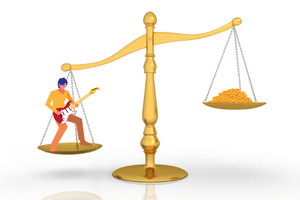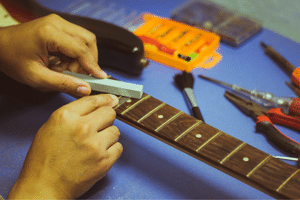Can you still find your dream guitar down the road? In this article, I’ll tell you the pros and cons of buying a guitar in a guitar store and reveal the tricks of the trade that will make your shopping experience a success, especially if you are a beginning player.
Keep on reading to learn everything you need to know!
You can use the table of contents below to take you to the area that interests you. Click on the little box to open it and then click on the section of the article you want to read, or you can read from start to finish if you want the full in-store shopping experience!

Are People Still Buying Guitars In A Store?
Music and record stores have been around forever. In the “old days,” they sold record albums, sheet music, and musical instruments all under one roof. Guitar specialty stores like Guitar Center and Daddy’s Junky Music (closed after 39 years) replaced many “mom and pop” shops that offered a small selection of guitars hung on the wall.
In most places, you can still find brick-and-mortar stores that sell guitars, and people are still buying them, especially beginners looking for something inexpensive to start their musical journey and maybe take a few lessons in the process.

In-Store Shopping Checklist
Before Arriving
- Set a price range – How much you can afford and what you are willing to pay
- Make a list of stores near you that sell guitars
- Check to see if they have a website to get an idea of their inventory and prices
- Look for online reviews of each store and check with organizations like the Better Business Bureau
- Select a day and a time when you will have at least 30 to 60 minutes to spend in each store
During Your Visit
- Bring a family member or friend that plays the guitar with you if you are a beginning guitar player
- Play the instrument before you purchase it and plug it into an amplifier if it is an electric guitar
- Visit as many stores as possible to see who has the best guitar selection and the lowest prices
- Check online to see if Amazon or any big guitar stores are offering the same guitar at a lower price
- Try to bargain with the store manager, especially if you find a cheaper price somewhere else
- Find out the store’s return policy and if they can service the guitar before you buy it
- Try to negotiate a free gig bag, guitar setup or guitar lesson into the price of the instrument
Keep On Reading To Learn More!

Advantages Of In-Store Shopping
- You can interact and learn from knowledgable and experienced staff
- Your guitar teacher can help pick a guitar that matches your skill level
- Guitars often look different in person than in a photo
- The guitar can be closely inspected for quality of craftsmanship
- Can play the guitar before you buy it to evaluate sound and performance
- The sound and playability of one guitar can be compared to that of another
- The guitar is easier to return than mailing it back to an online store
- You are helping to support your local businesses

Disadvantages Of In-Store Shopping
- Fewer guitar models to choose from than some online stores
- No objective buyer reviews
- The color you want may not be available
- You have to pay tax on the guitar
- Not as convenient as 24/7 online shopping

Quality Of Construction And Craftsmanship
Seeing a guitar up close and holding it in your hands before buying it can be a huge advantage. You are seeing the actual color of the guitar’s finish and the tone of the wood.
Is the true color of the body finish or tone of the wood what you expected? Things can look different when professionally photographed. Does a fast-food hamburger look like the photo in a commercial?
The weight and balance of the guitar are important, especially if it is a heavy electric like a Les Paul. Sometimes the weight on a spec sheet can be misleading.
Has the guitar been damaged by someone in the store or a previous owner? Pre-owned guitars can have subtle problems that are only revealed upon close inspection or when playing the instrument.
Damage And Defects In Craftsmanship
Here are some of the things to look for when you inspect a guitar.
Overall Fit And Finish
How well is the guitar assembled? Are there rough edges on metal or plastic pieces? Any blemishes in the neck or body finish. Does the finish have a high-quality polish? How about the quality of the wood grain, like the distinctiveness of a flame maple neck? Were screw heads stripped during assembly?
You might be surprised how guitars can leave the assembly line, depending on the skill and patience of the individual workers.
Tuning Machine quality
Does the guitar have good-quality tuning machines? Loosen and retighten the tuning machine for each string. Do they turn smoothly and move the string slowly?
Nut Material And Condition
What is the nut made of? Is it plastic, bone, TUSQ, Corian, etc.? The guitar’s volume, tone, and sustain are directly affected by the quality of the nut.
Closely inspect the guitar nut for any burrs or irregularities in the string slots by loosening each string enough to lift it and move it out of the way. You can do this while you are evaluating the tuning machines.
If the nut slots are not smooth or uneven, it can affect the guitar’s tuning stability, especially if it has a whammy bar! Are there any chips in the nut?
Neck Straightness
If you don’t have experience with guitars it can be difficult to visually evaluate the neck straightness.
The straightness of the neck can affect the way the guitar sounds and plays. The neck should have a slight downward bow (relief) in the middle area. Too much of a bow in either direction (downward or upward) can affect the guitar’s intonation, action, playability, and tone.
The neck may need a truss rod adjustment, which a guitar tech or luthier at the store may be able to do. Some necks may be damaged and cannot be appropriately adjusted. You should not attempt to adjust the truss rod if you don’t know the proper method, or you could permanently damage the neck (see the section below).
Fingerboard Feel
How does the fingerboard feel when you slide your fingers up and down the neck between the frets and bend the strings? It should feel smooth and natural.
Fret Condition
Are all the frets the same height and well-polished? Any fret “dents” or worn-out areas, especially with pre-owned guitars? Are there burrs or sharp edges on the ends of the frets, which may be more prevalent as you move up the neck? Do notes buzz on a particular fret when you press the string down, bend it, or do finger vibrato?
Bracing Integrity (Acoustic Guitars)
Look through the soundhole of an acoustic guitar to inspect the integrity of the bracing. Does everything appear to be glued down tightly? Faulty bracing can affect the guitar’s tone and durability.
Bridge Setup And Integrity
The guitar’s bridge is just as important for how the guitar will sound and play as the nut! A poorly designed or improperly installed and adjusted bridge can significantly affect the guitar’s intonation, tone, sustain, action, and playability.
For an electric guitar, each of the bridge saddles should be at the proper height and appear to follow the curvature of the fretboard. If the guitar has a vibrato bridge, it should be adjusted appropriately and have a smooth action when the pitch of the strings is lowered and raised. The guitar should stay in tune while using the whammy bar.
If the guitar is acoustic, the bridge saddle and pins should be made of high-quality material, and the pins should fit properly.

Guitar Sound And Performance
A guitar that looks great but plays poorly or sounds bad is not a good investment.
Spend as much time as you can playing different guitars and comparing their sound and playability to each other. Be aware that two guitars of the same make and model can sound or play differently.
Play the guitars sitting and ask for a guitar strap so you can play them standing. Is the guitar comfortable and well-balanced in each of these playing positions?
Bring your guitar pick and try fingerpicking each instrument too. If the guitars are electric, play them acoustically and through various amplifiers. If an electric guitar doesn’t sound good acoustically, the amplifier is just masking the problem with the instrument, which could be as simple as an adjustment or string change.
Don’t fall for the trick of judging the guitar while a salesperson plays it for you. An excellent and experienced player can dazzle you with technique so that you won’t notice the shortcomings of the guitar! Even if you don’t know how to play yet, strum it and pick some individual notes to judge if it feels right for you. Here’s where bringing a guitar player with you can help.
Problems With Sound And Performance
Here are some things to look for when you play the guitar.
Improper Setup And Action
The way a guitar is set up and the action (distance from the top of the frets to the bottom of the strings) can drastically affect how it plays and sounds. Electric guitars are easier to adjust than acoustic guitars.
If the guitar is difficult to play, has string buzzing, doesn’t sound good acoustically, or lacks sustain, it may need a setup or string change. Ask the salesperson to bring out another guitar of the same make and model or make the proper adjustments to the guitar to correct the problem before buying it.
If you intend to change the string gauge, ask the store owner to do it and then set up the guitar before buying it.
String buzz
You should be able to play notes and chords all over the neck without string buzz or loss of sustain, even when using the whammy bar on an electric guitar. String height (set too low), neck back-bow, fret problems, and bad strings are the most common causes of sting buzz. A bad nut can cause string buzz on the open strings.
“Scratchy” Volume And Tone Knobs & Pickup Selector Switch
Volume and tone knobs or a pickup selector switch that make a “scratchy” sound or intermittent loss of sound in the amplifier are usually from cheap, dirty, or worn-out components. If the guitar is new, do not buy the guitar. If it is pre-owned, the store may be able to correct the problem by properly cleaning the components or installing new ones.
Pickup Problems
Pickups that are adjusted too high up to the strings can cause problems with intonation and tone. Pickups that are too low can sound weak with poor sustain. There is a “sweet spot” for pickup height, which depends on the guitar, pickup type, and string gauge & material.
The pickup height should be properly adjusted when the guitar leaves the factory. Try playing the guitar through various amplifiers before you make a final judgment on the pickups. Cheap pickups will not sound good, no matter how you adjust them or what amp you use.
Tone
It’s essential to judge the tone of a guitar carefully. Play it with both a pick and using your fingers. If it is an electric guitar, be sure to play it unplugged. Listen for tone richness and character. Some guitars naturally sound more trebly, mid-rangy, or bassy. It comes down to individual preference and the type of music you play.
Sustain
Even with the proper setup, some guitars sustain less than others. This can depend on strings, pickups, neck and body wood type, and wood thickness. With electric guitars, thicker bodies (e.g., a Les Paul) and better pickups generally have better note sustain.
Sound Projection (Acoustic Guitars)
Acoustic guitars with bigger bodies can have better sustain and sound projection, but many other factors can come into play. The easiest way to find out is to have someone else play the guitar while you listen from a distance.
Whammy Bar
The type of whammy (vibrato) bar system and how it is set up determine how it sounds and functions. If you don’t use the whammy bar, unscrew it and have the store tech adjust the bridge to sit flat against the guitar’s body.
Check t be sure that the guitar does not go out of tune when using the bar. It may need to be set up correctly, or it may not be adequate for your playing style.
If you use the bar conservatively, then a standard vibrato bridge with a standard nut should work ok (think typical Strat). If you are more aggressive with the bar, then you might need a special nut (graphite, TUSQ, roller-nut) and locking tuners to keep the guitar in tune as you play.
If you like guitar flash with whammy bar “divebombs,” you’re most likely looking at getting a guitar with a double locking system (locking bridge and locking nut). Think Ibanez or equivalent guitar.
Play the guitar aggressively and put the whammy bar through all its paces to ensure it will work for you.

Beware Of The Store’s Return Policy!
To prevent buyer’s remorse, check to be sure that the store has a reasonable return policy and if there is a “restocking fee.”
Even if you like the guitar in the store after playing it a while, you may find it uncomfortable on your hands or not musically versatile enough after you get it home.
Your purchase paperwork should include the store’s return policy and specific information regarding any warranty and seller’s obligations the instrument might have.
A music store that has been in business for many years and has a good reputation is always a safe bet.

Is Buying From A Store Still Legit?
Absolutely! It’s a tremendous advantage to be able to see and play the guitar before you buy it. Going to a music store also gives you the opportunity to comparison-shop to see which guitar works best for you.
As with any major purchase, you have to be well-informed and thoughtful, no matter where you buy it.

Key Takeaways
- Do your online research to learn about the guitars you are interested in, including user reviews and the lowest price
- Plan to visit several stores and take your time to play each guitar
- Ask questions about each guitar and voice potential concerns
- Negotiate with the store owner or manager to get the online price
- Don’t make a hasty purchase, you can think about it and return at a later date
- Ask the store to inspect the guitar and do a setup before completing the sale
- Get the appropriate paperwork and clarify the store’s return policy

Are You Qualified To Make Guitar Adjustments Or Modifications?
It’s great to work on your guitars, especially if you have a lot of them, but you should always be aware of your limitations.
Adjusting things like an electric guitar’s string height (action) or pickup height can be straightforward. Still, some adjustments require the proper training and experience, like adjusting a guitar’s truss rod.
When you doubt your ability to adjust, repair, or modify your guitar, it’s always best to bring it to a competent guitar technician or luthier (guitar designer & builder). You can permanently damage your guitar, and it might never play and sound right again!
Making modifications to your guitar can void its manufacturer’s warranty and cause permanent damage to the instrument. Certain modifications are irreversible, so you may be stuck with them, even if you desperately want to restore the guitar to its original condition!
I learned that the hard way over the years until I did a three-year apprenticeship in a guitar repair shop. Now I have my own home workshop with the proper training and equipment to safely maintain and repair all my instruments.
Remember: “When In Doubt, Send It Out!” In this case, it’s probably best to let the music store make any necessary adjustments to the guitar before you purchase it.

Frequently Asked Questions
Here are some of the questions I get asked about buying a guitar in a music store.
If your question does not appear here, please put it in the comments, and I will get right back to you with an answer.
Do All Guitars Come With Cases?
No. These days, if you are paying less than $1,000 for a guitar, you can expect to have to buy a case separately. If the guitar needs a case, you can usually bargain with the store manager or owner to give you a gig bag to make the sale.
Will A Gig Bag Protect My Guitar?
Yes, but how well a gig bag protects your guitar depends on the bag’s quality and what you will do with the guitar. A cheap gig bag may not be water-resistant or have enough padding to protect the guitar finish from being chipped if it is bumped or dropped.
If you will travel a lot with the guitar, especially by plane, then get yourself a hardshell case that is designed to be mishandled.
For more info, see Cheap Guitar Gig Bags – 8 Best Options For Under $100! and How To Store A Guitar – Avoid These Mistakes To Keep It Safe.
Does A Brand New Guitar Need To Be Set Up?
It will often require at least a minor setup, depending on who assembled the instrument, how many times it has been played, if the string gauge has been changed, and if it has endured frequent temperature changes.
Ask the store to check the guitar and do a free setup before purchasing it.
Do Guitars Come With Paperwork?
Yes. You should not leave the store without a written receipt that shows you are the guitar owner. New guitars should also come with a “hangtag” and an owner’s manual. Expensive guitars like custom shop models should come with a certificate of authenticity.

Final Thoughts – add keyword
I hope you enjoyed this article, and it gave you the information you needed to purchase a guitar from a local music store with confidence! Buy a guitar from a store or online both have their advantages and disadvantages.
One of the biggest advantages of an in-store purchase is the ability to see and play the guitar before you purchase it.

The best approach is to research a guitar online for pros, cons, and best price before playing it at a music store. Store owners are typically eager to make sales, especially in smaller establishments, and will be willing to give you a fair deal.
For more info, see Online Guitar Shopping – The Good, The Bad, And The Ugly!

Tell Me What You Think
Please leave a comment below if you enjoyed this article, have any questions about buying a guitar in a guitar store, or want to give your point of view. I will be happy to help you.
- Do you favor buying a guitar in-person or online? Why?
- What was the last guitar you bought at a music store? Were you happy with the purchase? Did you get a good deal? Would you go back to buy another guitar?
- After reading this article, are you more likely to buy a guitar at a music store?



I love the sound of the guitar ! My brother is a guitarist and has several scattered around the home. Acoustic and electric.
He always goes into a store to purchase as it’s much more personable and as you have mentioned, you can get a proper feel of the instrument that you are buying and it’s important to try before you buy when they are not the cheapest instrument.
Much more difficult online, especially if you’re a newbie.
Never realised that you get charged tax when purchasing one online.
He will find your article of interest so I will pass it on to him.
A great article, thanks for sharing.
Louise
Hi, Louise
Thank You for your comments!
I love going into the various music stores where I live. Unfortunately, the one I grew up with has closed due to online competition issues. I played plenty of guitars in that store that I never purchased, but I bought some too.
In the USA, if you buy a guitar online from a company that has a brick-and-mortar store in the state where you live (like a Guitar Center), the chances are that you will be charged state tax at the time of purchase.
Perhaps you should give the guitar a try and have your brother give you some lessons! 😊
Frank
The name of your site intrigues me, I love it. Thank you for this great post, thank you for all the great advice. My son wants a guitar and wants to learn to play. Your post today helped so much, for the both of us. I did not know where to even start, or what to look for. Now I have more knowledge, thanks to you.
This coming weekend it’s guitar buying time. We will be back to your site for some more great tips and advice.
Hi, Marlene
Thank You for your comments!
I’m thrilled that my article helped you. Getting your son a guitar is one of the best ideas of all! A starter guitar should be pretty straightforward; just follow my recommendations. Remember, you don’t have to spend a lot of money to get a good entry-level instrument. You can always trade up as the need arises.
You might find yourself attracted to playing the guitar after you see how much fun it can be! In the comments section of my article, let me know if you have any questions.
Frank